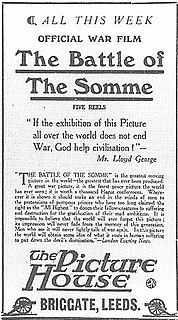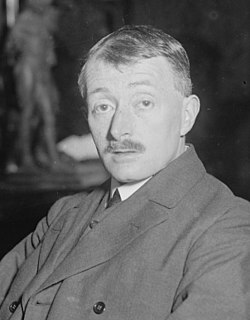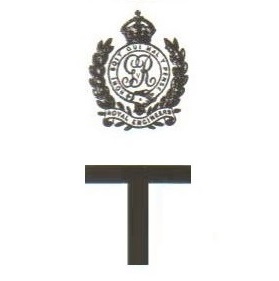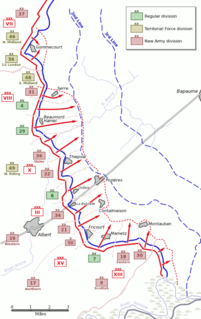
The Battle of the Somme, also known as the Somme offensive, was a battle of the First World War fought by the armies of the British Empire and French Third Republic against the German Empire. It took place between 1 July and 18 November 1916 on both sides of the upper reaches of the Somme, a river in France. The battle was intended to hasten a victory for the Allies. More than three million men fought in the battle and one million men were wounded or killed, making it one of the deadliest battles in human history.

The Battle of the Somme, is a 1916 British documentary and propaganda war film, shot by two official cinematographers, Geoffrey Malins and John McDowell. The film depicts the British Expeditionary Force in the preliminaries and early days of the Battle of the Somme. The film premièred in London on 10 August 1916 and was released generally on 21 August. The film depicts trench warfare, marching infantry, artillery firing on German positions, British troops waiting to attack on 1 July, treatment of wounded British and German soldiers, British and German dead and captured German equipment and positions. A scene during which British troops crouch in a ditch then "go over the top" was staged for the camera behind the lines.

The first day on the Somme, 1 July 1916, was the beginning of the Battle of Albert (1–13 July), the name given by the British to the first two weeks of the 141 days of the Battle of the Somme in the First World War. Nine corps of the French Sixth Army and the British Fourth and Third armies attacked the German 2nd Army from Foucaucourt to the south of the Somme, northwards across the Somme and the Ancre to Serre and at Gommecourt, 2 mi (3 km) beyond, in the Third Army area. The objective of the attack was to capture the German first and second defensive positions from Serre south to the Albert–Bapaume road and the first position from the road south to Foucaucourt.

The Lochnagar mine south of the village of La Boisselle in the Somme département was an underground explosive charge, secretly planted by the British during the First World War, to be ready for 1 July 1916, the first day on the Somme. The mine was dug by the Tunnelling Companies of the Royal Engineers under a German field fortification known as Schwabenhöhe.

The Battle of Pozières took place in northern France around the village of Pozières, during the Battle of the Somme. The costly fighting ended with the British in possession of the plateau north and east of the village, in a position to menace the German bastion of Thiepval from the rear. The Australian official historian Charles Bean wrote that Pozières ridge "is more densely sown with Australian sacrifice than any other place on earth".

The Old Front Line (ISBN 0-85052-936-0) is a military history book by English poet John Masefield, first published in 1917.
Richard van Emden is a British author and television documentary producer who specialises in the First World War.

The Manchester Pals were pals battalions of the British Army raised in 1914 during the Great War, formed as part of Lord Kitchener's New Armies. They were formed into eight battalions of the Manchester Regiment.
Devonshire Cemetery is a small Commonwealth War Graves Commission (CWGC) burial site for some of the British Empire and Commonwealth troops killed during the Battle of the Somme. It is located near to the village of Mametz. The cemetery grounds were assigned to the British Empire in perpetuity by the French state in recognition of the sacrifices made by the Allies in the defence of France during the First World War.

The Capture of La Boisselle was a tactical incident during the Battle of Albert, the name given by the British to the first two weeks of the Battle of the Somme. The village of La Boisselle forms part of the small commune of Ovillers-la-Boisselle about 22 mi (35 km) north-east of Amiens in the Somme department in Picardie in northern France. To the north-east of La Boisselle lies Ovillers; by 1916, the village was called Ovillers by the British Expeditionary Force (BEF) to avoid confusion with La Boisselle, south of the road.

The 174th Tunnelling Company was one of the tunnelling companies of the Royal Engineers created by the British Army during World War I. The tunnelling units were occupied in offensive and defensive mining involving the placing and maintaining of mines under enemy lines, as well as other underground work such as the construction of deep dugouts for troop accommodation, the digging of subways, saps, cable trenches and underground chambers for signals and medical services.

The 178th Tunnelling Company was one of the tunnelling companies of the Royal Engineers created by the British Army during World War I. The tunnelling units were occupied in offensive and defensive mining involving the placing and maintaining of mines under enemy lines, as well as other underground work such as the construction of deep dugouts for troop accommodation, the digging of subways, saps, cable trenches and underground chambers for signals and medical services.

The 179 Tunnelling Company was one of the tunnelling companies of the Royal Engineers created by the British Army during World War I. The tunnelling units were occupied in offensive and defensive mining involving the placing and maintaining of mines under enemy lines, as well as other underground work such as the construction of deep dugouts for troop accommodation, the digging of subways, saps, cable trenches and underground chambers for signals and medical services. 179th Tunnelling Company is particularly known for its role at L'îlot de La Boisselle and for firing the Lochnagar mine during the Battle of the Somme 1916. The Lochnagar mine formed part of a series of 19 mines that were placed beneath the German lines on the British section of the Somme front to assist the start of the battle.

The 183rd Tunnelling Company was one of the tunnelling companies of the Royal Engineers created by the British Army during World War I. The tunnelling units were occupied in offensive and defensive mining involving the placing and maintaining of mines under enemy lines, as well as other underground work such as the construction of deep dugouts for troop accommodation, the digging of subways, saps, cable trenches and underground chambers for signals and medical services.

The 185th Tunnelling Company was one of the tunnelling companies of the Royal Engineers created by the British Army during World War I. The tunnelling units were occupied in offensive and defensive mining involving the placing and maintaining of mines under enemy lines, as well as other underground work such as the construction of deep dugouts for troop accommodation, the digging of subways, saps, cable trenches and underground chambers for signals and medical services.

The 19 mines on the first day of the Somme comprised a series of underground explosive charges, secretly planted by British tunnelling units beneath the German front lines on the Western Front during the First World War, ready to be detonated in the morning of Saturday 1 July 1916, the first day of the Battle of the Somme. The joint explosion of these mines ranks among the largest artificial non-nuclear explosions.
L'îlot de La Boisselle is a small, 3.12-hectare (7.7-acre) historic site in the commune of Ovillers-la-Boisselle in the Somme department in Picardie in northern France. L'îlot was heavily fought over during the First World War, when it was known as Granathof to the Germans and as Glory Hole to British soldiers. The site is private property and open to the public by appointment with Claudie LLewellyn.

In World War I, the small commune of Ovillers-la-Boisselle, located some 22 miles (35 km) north-east of Amiens in the Somme department in Hauts-de-France in northern France, was the site of intense and sustained fighting between German and Allied forces. Between 1914 and 1916, the Western Front ran through the commune, and the villages were completely destroyed. After the Armistice of 11 November 1918, the former inhabitants returned and gradually rebuilt most of the infrastructure as it had been before the war.

The Y Sap mine was an underground explosive charge, secretly planted by the British during the First World War and ready for 1 July 1916, the first day on the Somme. The mine was dug by the Tunnelling Companies of the Royal Engineers under a German machine-gun nest known as Blinddarm (appendix) in the front line, on the north side of the village of La Boisselle in the Somme département. The mine was named after Y Sap, the British trench from which the gallery was driven. It was one of 19 mines on the British sector to be blown at the start of the battle.






